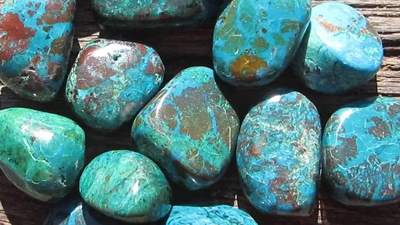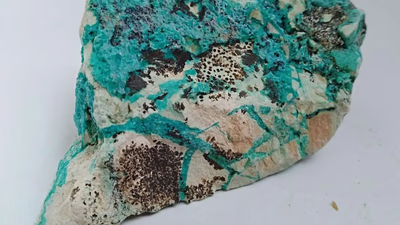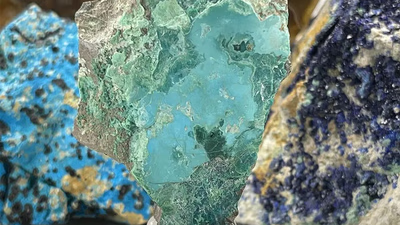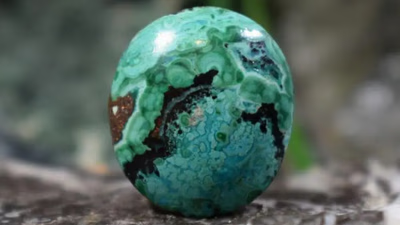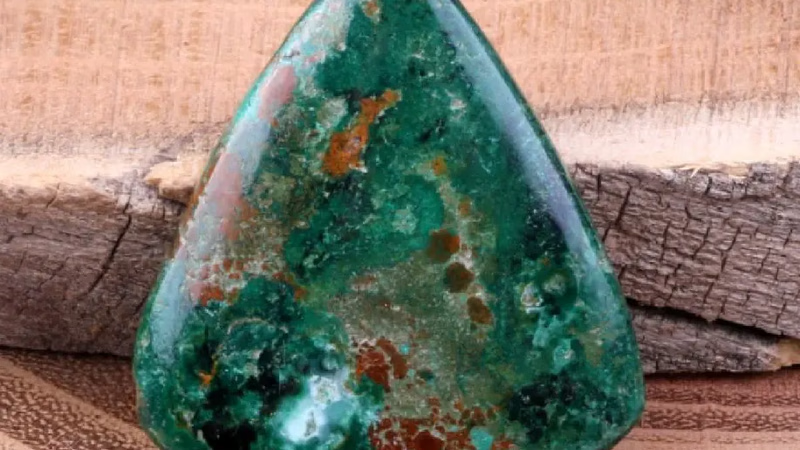
Chrysocolla gemstones showcasing vibrant colors and unique textures.
Chrysocolla is a captivating gemstone that comes in various types and appearances, often influenced by its formation and associations with other minerals. One of the pure forms of chrysocolla is typically vibrant blue to green in color and can be found in massive or botryoidal (grape-like) forms. It tends to have a translucent to opaque transparency and can exhibit a smooth or slightly rough texture. Another type is chrysocolla with quartz, which includes variations like Chrysocolla Chalcedony (Gem Silica) known for its bright, translucent blue to green color, and Chrysocolla in Quartz, which combines chrysocolla with clear quartz, enhancing its durability and making it more suitable for jewelry. Chrysocolla can also be found in combination with other copper minerals, such as Eilat Stone from Israel, which is a mix of chrysocolla, turquoise, malachite, and other minerals, displaying a striking mix of blue and green hues. Sonora Sunrise is another example, consisting of chrysocolla, cuprite, and other minerals, known for its vibrant blue-green and red patterns, and it is named after the Sonora Desert.
To accurately identify chrysocolla and distinguish it from similar stones, several factors should be considered. These include observing the characteristic blue to green hues and mottled or uneven color distribution, performing a hardness test due to chrysocolla's relative softness (2.5-3.5 on the Mohs scale), measuring the specific gravity (typically around 2.0-2.4), and examining the stone's luster (vitreous to dull) and transparency (translucent to opaque). For definitive identification, consulting a gemologist who can use advanced techniques like spectroscopy or X-ray diffraction is recommended.
Chrysocolla is one of the minerals and precious stones in copper. Although there is no similar gemstone to Chrysocolla, there are stones that contain copper, including turquoise, malice, azurite, and paraiba tourmaline. Many stones may also have a spotted appearance and a similar color and shine to this stone. Some of the stones that often confuse people and misdiagnose chrysocolla are Larimar, Turquoise, Azure, Varicose Veins and Smithsonian.
Pure chrysocolla is actually quite rare; most sediments of this rock are mixed with other minerals and compounds. In some cases, mixed chrysocolla stones and specific regional specimens are sold under different names. But most suppliers simply sell them as "Chrysocolla" because its brand is unofficial. The most similar gemstones and minerals known Azurite, crystalline or crystalline azurite, Apache chrysocolla (Arizona region, mixed chrysocula, turquoise, jasper, azure, malachite and quartz), Eilat stones (combined chrysocula, azure, azurite, and malachite and Eilat turquoise, Israel) are the most similar and well-known gemstones and minerals to Chrysocolla.
- Weight: The weight of the stone or jewelry is the first important factor in pricing that jewelry.
- Color: Another major factor in pricing is the color of the stone, which is very important.
- Purity: The purity of the stones is very important in pricing. The purity and impurity of the stone, which means the combination of other minerals with the stone in question, is very important in the price of the stone and is divided from IF to I3I.
- Type of stone cutting: The cutting of each stone must be done carefully and delicately because proper cutting of the stone multiplies the final value of the stone.
- Transparency: The degree of transparency of the stone is indicated by the letters D to M. This classification of D as the clearest starting degree and up to M as the most opaque degree of the stone continues.
The only reason this spectrum of transparency starts with the letter D is because, in the exploration of future mines, clearer gems may be found than existing gemstones, and may be graded A, B, and C. The degree and method of pricing a gemstone based on the above system, position A is the highest quality and most expensive stone and in position Z, the worst and cheapest stone. You can buy the stone you want based on the amount of money you have.
There are several stones that can be mistaken for chrysocolla due to their similar color and appearance. Turquoise, for instance, shares a blue to green color range with chrysocolla, but it is harder with a Mohs hardness of 5-6. Turquoise often displays a more uniform color and distinct veining patterns that set it apart from chrysocolla. Malachite, on the other hand, is a rich green stone with banding or swirling patterns, similar to chrysocolla in hardness (3.5-4). However, malachite's banding and deeper green color differentiate it from the typically blue-green chrysocolla. Azurite, with its deep blue color, can resemble the blue hues of chrysocolla, but it is softer (Mohs hardness 3.5-4) and often occurs in crystalline forms, whereas chrysocolla is usually massive. Variscite is another stone that shares a green to bluish-green color with chrysocolla, but it has a slightly higher hardness (Mohs hardness 4.5-5) and often has a more waxy luster. Smithsonite, with its various colors, including blue and green, can resemble chrysocolla, but it can have a botryoidal form and a more pearly luster.
